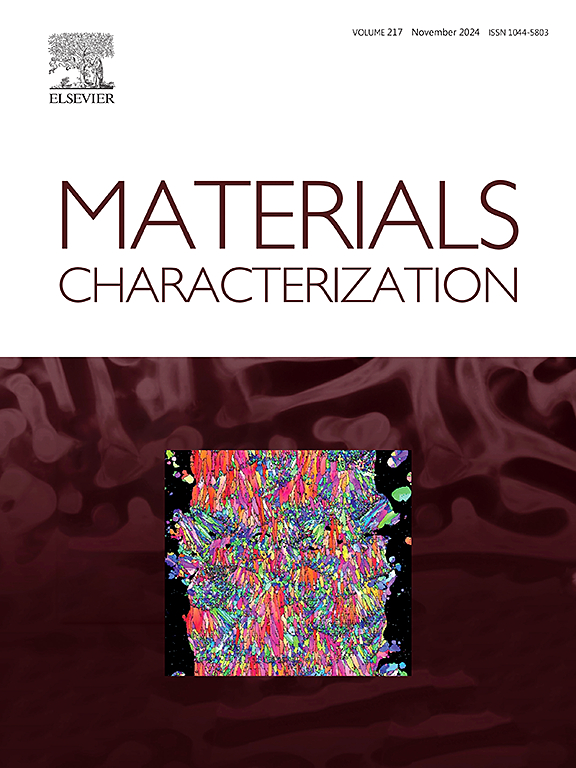Al- ceo2原位反应制备Al基复合材料的微观结构和力学性能
IF 5.5
2区 材料科学
Q1 MATERIALS SCIENCE, CHARACTERIZATION & TESTING
引用次数: 0
摘要
本研究报告了在设计耐热Al基复合材料方面的突破,通过控制Al- ceo2原位反应,通过非晶Al2O3 (am-Al2O3)和Al11Ce3之间的新型界面相互稳定机制获得了优异的热稳定性。通过调节热压温度(490-610℃),拉伸强度可以在52%的范围内调节(143-218 MPa, 350℃),直接由am-Al2O3层包裹Al11Ce3和CeO2纳米颗粒的独特核壳结构的演变决定。详细的表征表明,am-Al2O3壳层有效地抑制了Al11Ce3的粗化,而Al11Ce3核层在化学上稳定了am-Al2O3的结晶,这是一种相互的稳定效应。在350°C退火1000 h和450°C退火360 h后,复合材料保持了98.8%的原始强度。同时,复合材料表现出优异的耐腐蚀性(重量减轻0.03 mg·cm−3,而2219铝合金的重量减轻4.14 mg·cm−3)。这项工作建立了一种利用非晶界面协同作用的新材料设计范式,为定制高温复合材料提供了途径。本文章由计算机程序翻译,如有差异,请以英文原文为准。
Microstructure and mechanical properties of Al matrix composites produced by Al-CeO2 in-situ reaction
This study reports a breakthrough in designing heat-resistant Al matrix composites through a controlled Al-CeO2 in-situ reaction, achieving exceptional thermal stability via a novel interfacial mutual stabilization mechanism between amorphous Al2O3 (am-Al2O3) and Al11Ce3. By regulating the hot-pressing temperature (490–610 °C), it is demonstrated that the tensile strength can be modulated over a 52 % range (143–218 MPa, 350 °C), directly governed by the evolution of a unique core-shell structure where am-Al2O3 layers encapsulate Al11Ce3 and CeO2 nanoparticles. Detailed characterization reveals that the am-Al2O3 shell effectively suppresses Al11Ce3 coarsening, while the Al11Ce3 core chemically stabilizes the am-Al2O3 against crystallization – a reciprocal stabilization effect. The composite retains >98.8 % of its original strength after annealing at 350 °C for 1000 h and 450 °C for 360 h. Concurrently, the composite displays exceptional corrosion resistance (0.03 mg·cm−3 weight loss vs. 4.14 mg·cm−3 for 2219 Al alloy). This work establishes a new materials design paradigm leveraging amorphous-crystalline interfacial synergy, providing a pathway to tailor high-temperature composites.
求助全文
通过发布文献求助,成功后即可免费获取论文全文。
去求助
来源期刊

Materials Characterization
工程技术-材料科学:表征与测试
CiteScore
7.60
自引率
8.50%
发文量
746
审稿时长
36 days
期刊介绍:
Materials Characterization features original articles and state-of-the-art reviews on theoretical and practical aspects of the structure and behaviour of materials.
The Journal focuses on all characterization techniques, including all forms of microscopy (light, electron, acoustic, etc.,) and analysis (especially microanalysis and surface analytical techniques). Developments in both this wide range of techniques and their application to the quantification of the microstructure of materials are essential facets of the Journal.
The Journal provides the Materials Scientist/Engineer with up-to-date information on many types of materials with an underlying theme of explaining the behavior of materials using novel approaches. Materials covered by the journal include:
Metals & Alloys
Ceramics
Nanomaterials
Biomedical materials
Optical materials
Composites
Natural Materials.
 求助内容:
求助内容: 应助结果提醒方式:
应助结果提醒方式:


